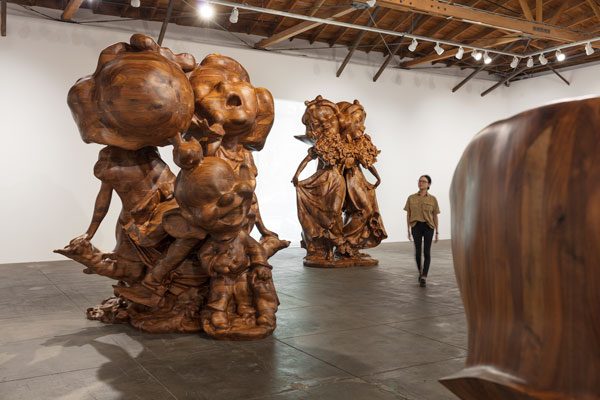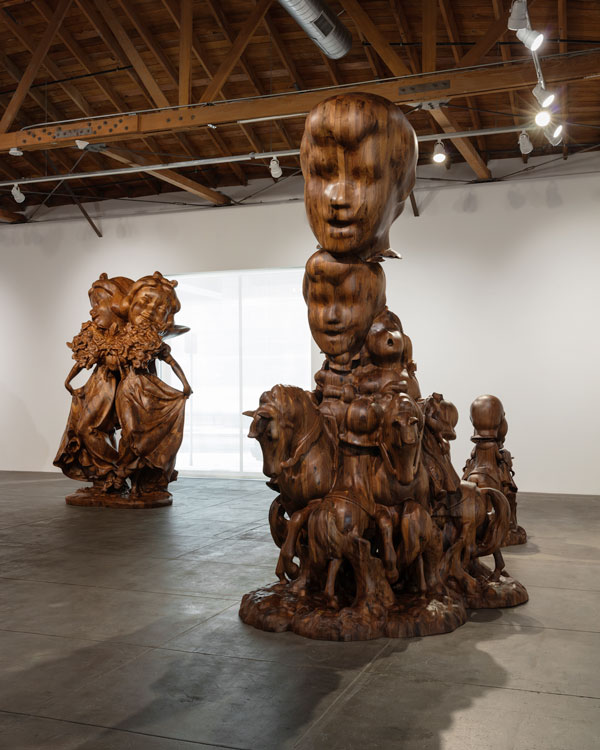Roughly four years ago, Paul McCarthy opened the sprawling installation “WS” at the Park Avenue Armory in New York, platforming (and rupturing) the domestic fantasy at the center of Disney’s Snow White fairy tale while playing out a vivisection of its narrative on screens surrounding the centerpiece installation. The filmed component—itself an extension of the domestic fantasy—also played out a drama of authorship and agency, with McCarthy himself standing in as ‘Walt’ for the Disney who spawned both the original 1937 animated film and the film and theme park empire that soon followed.
McCarthy’s sculptures and their installation at Hauser & Wirth both explode and elevate that notion of authorship. The entire notion of mass merchandising characters or content from another commercial vehicle is an implicit dilution and corruption of the original product’s authorship. (Yet what authorship, apart from its legal/commercial definition, actually means in the context of the underlying folk material from which “WS” was constructed, is itself ambiguous.) With these WS/Wood Statue Spinoffs, McCarthy has overcompensated—multiplying, merging and rotating (as well as magnifying) the figures.
This is some distance from both the stuff of Grimm’s Fairy Tales and Disney—and for that matter, McCarthy’s own Armory production of “WS.” Consider the multiplications, inversions and shifting of scale in WS, Erection (2012). McCarthy underscores where the fairy tale is carrying us, surmounting the Prince’s head with an even larger head. But isn’t this also a metaphor for authorship? It’s also straightforwardly a decapitation.

Installation view, Paul McCarthy. WS Spinoffs, Wood Statues, Brown Rothkos , Hauser & Wirth Los Angeles, 2017 © Paul McCarthy, courtesy the artist and Hauser & Wirth photo by Fredrik Nilsen
Finally the “double-head” makes the top half of the statue significantly taller than the lower half, the decapitation offset by a multiplication below. You might need a troika or a quartet of horses to bear the weight of those poly-hypercephalic fairy gods; but one is turned opposite his mates—not unlike Snow White turned into the Prince’s chest as if directly absorbed (the ultimate patriarchal appropriation) in WS, Erection.
There is a stasis, weight and density to the scale of these sculptures; the violence we associate with the McCarthy brand has metamorphosed into something else altogether—a kind of etherized Baroque. The monumentality could be said to stand in for the violence—yet the violence is still there. The bookended figures (multiple, ambiguously placed horses in WS, Bookends, 2013) stand alternately upright and turned 90 degrees, as if upended—the horses’ legs pushing against the upright bookend support, the sculptures seemingly felled by their own top-heavy imbalance.
This is not McCarthy’s first excursion into this particular sculptural terrain—always seemingly drawn to German kitsch. Here, finger-in-the-eye impudence has given way to something both monumental and exhausted (and perhaps, given the medium, and despite its solidity, vulnerable). The rounded Hummel sentimentality has been blown up into a Baroque ecstatic-verging-on-extinction. It is not the fantasy inversion/invocation of primal violence at war with the rational; it is that primal violence as the ultimate expression of the rational. McCarthy’s precise machining of the black walnut wood into a kind of pixelated marquetry of blocks underscores that rationalization and suggests that he has stumbled across a nexus between the terrain of gemeineschaft and gesellschaft—the ‘happiest’ (or unconscious) places on a very unhappy (depleted, late capitalist) earth.


